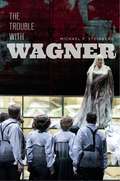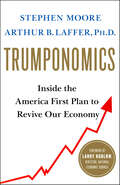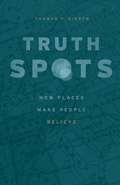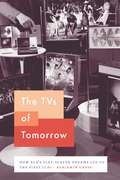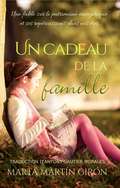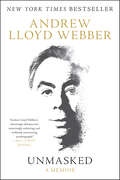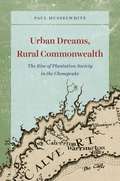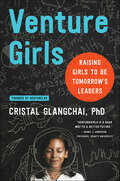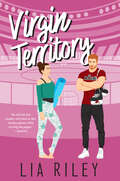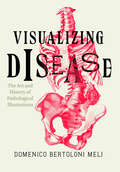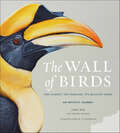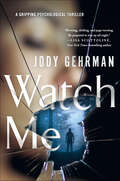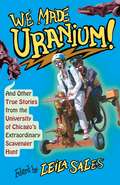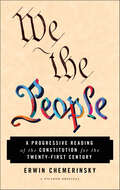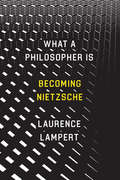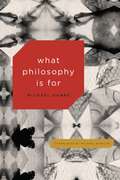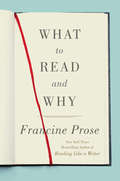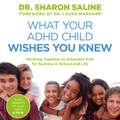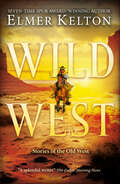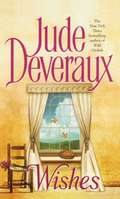- Table View
- List View
The Trouble with Wagner
by Michael P. SteinbergIn this unique and hybrid book, cultural and music historian Michael P. Steinberg combines a close analysis of Wagnerian music drama with a personal account of his work as a dramaturg on the bicentennial production of The Ring of the Nibelung for the Teatro alla Scala Milan and the Berlin State Opera. Steinberg shows how Wagner uses the power of a modern mythology to heighten music’s claims to knowledge, thereby fusing not only art and politics, but truth and lies as well. Rather than attempting to separate value and violence, or “the good from the bad,” as much Wagner scholarship as well as popular writing have tended to do, Steinberg proposes that we confront this paradox and look to the capacity of the stage to explore its depths and implications. Drawing on decades of engagement with Wagner and of experience teaching opera across disciplines, The Trouble with Wagner is packed with novel insights for experts and interested readers alike.
Trumponomics: Inside the America First Plan to Revive Our Economy
by Stephen Moore Arthur B. LafferDonald Trump promised the American people a transformative change in economic policy after eight years of stagnation under Obama. But he didn’t adopt a conventional left or right economic agenda. His is a new economic populism that combines some conventional Republican ideas–tax cuts, deregulation, more power to the states–with more traditional Democratic issues such as trade protectionism and infrastructure spending. It also mixes in important populist issues such as immigration reform, pressuring the Europeans to pay for more of their own defense, and keeping America first. In Trumponomics, conservative economists Stephen Moore and Arthur B. Laffer offer a well-informed defense of the president's approach to trade, taxes, employment, infrastructure, and other economic policies. Moore and Laffer worked as senior economic advisors to Donald Trump in 2016. They traveled with him, frequently met with his political and economic teams, worked on his speeches, and represented him as surrogates. They are currently members of the Trump Advisory Council and still meet with him regularly. In Trumponomics, they offer an insider’s view on how Trump operates in public and behind closed doors, his priorities and passions, and his greatest attributes and liabilities. Trump is betting his presidency that he can create an economic revival in America’s industrial heartland. Can he really bring jobs back to the rust belt? Can he cut taxes and bring the debt down? Above all, does he have the personal discipline, the vision, the right team, and the right strategy to pull off his ambitious economic goals? Moore and Laffer believe that he can pull it off and that Trumponomics will usher in a new era of prosperity for all Americans.
Truth-Spots: How Places Make People Believe
by Thomas F. GierynWe may not realize it, but truth and place are inextricably linked. For ancient Greeks, temples and statues clustered on the side of Mount Parnassus affirmed their belief that predictions from the oracle at Delphi were accurate. The trust we have in Thoreau’s wisdom depends in part on how skillfully he made Walden Pond into a perfect place for discerning timeless truths about the universe. Courthouses and laboratories are designed and built to exacting specifications so that their architectural conditions legitimate the rendering of justice and discovery of natural fact. The on-site commemoration of the struggle for civil rights—Seneca, Selma, and Stonewall—reminds people of slow but significant political progress and of unfinished business. What do all these places have in common? Thomas F. Gieryn calls these locations “truth-spots,” places that lend credibility to beliefs and claims about natural and social reality, about the past and future, and about identity and the transcendent. In Truth-Spots, Gieryn gives readers an elegant, rigorous rendering of the provenance of ideas, uncovering the geographic location where they are found or made, a spot built up with material stuff and endowed with cultural meaning and value. These kinds of places—including botanical gardens, naturalists’ field-sites, Henry Ford’s open-air historical museum, and churches and chapels along the pilgrimage way to Santiago de Compostela in Spain—would seem at first to have little in common. But each is a truth-spot, a place that makes people believe. Truth may well be the daughter of time, Gieryn argues, but it is also the son of place.
The TVs of Tomorrow: How RCA’s Flat-Screen Dreams Led to the First LCDs (Synthesis Ser.)
by Benjamin GrossIn 1968 a team of scientists and engineers from RCA announced the creation of a new form of electronic display that relied upon an obscure set of materials known as liquid crystals. At a time when televisions utilized bulky cathode ray tubes to produce an image, these researchers demonstrated how liquid crystals could electronically control the passage of light. One day, they predicted, liquid crystal displays would find a home in clocks, calculators—and maybe even a television that could hang on the wall. Half a century later, RCA’s dreams have become a reality, and liquid crystals are the basis of a multibillion-dollar global industry. Yet the company responsible for producing the first LCDs was unable to capitalize upon its invention. In The TVs of Tomorrow, Benjamin Gross explains this contradiction by examining the history of flat-panel display research at RCA from the perspective of the chemists, physicists, electrical engineers, and technicians at the company’s central laboratory in Princeton, New Jersey. Drawing upon laboratory notebooks, internal reports, and interviews with key participants, Gross reconstructs the development of the LCD and situates it alongside other efforts to create a thin, lightweight replacement for the television picture tube. He shows how RCA researchers mobilized their technical expertise to secure support for their projects. He also highlights the challenges associated with the commercialization of liquid crystals at RCA and Optel—the RCA spin-off that ultimately manufactured the first LCD wristwatch. The TVs of Tomorrow is a detailed portrait of American innovation during the Cold War, which confirms that success in the electronics industry hinges upon input from both the laboratory and the boardroom.
Un cadeau de la famille
by Marta Martín GirónLe premier roman qui traite des répercussions de notre héritage énergétique Très souvent il nous arrive des choses que nous ne savons expliquer, des situations qui nous font souffrir parce que nous ne les comprenons pas. Nous en arrivons même à accuser le destin de notre malheur ou notre tristesse, de notre maladie ou celle d'un être cher, de nos carences ou limitations. Mais, que se passerait-il si tout cela était un cadeau qui se transmet de génération en génération pour soigner quelqu'un d'autre pour nos ancêtres ? Que se passerait-il si nos expériences étaient le fruit d'expériences passées, de notre mémoire transgénérationnelle ? Que se passerait-il si les troubles physiques apportaient un message qui peut être biodécodé ? Que se passerait-il si nous devenions conscient de toutes ces expériences et si nous soignions nos problèmes? Nous sentirions-nous libres ? Récupérerions-nous notre santé ? Reconduirions-nous notre chemin et trouverions-nous de nouveaux objectifs ? Ce livre est basé sur une histoire réelle, sur les expériences de l'auteure elle-même par rapport aux circonstances de sa vie qu'elle ne réussissait pas à comprendre mais dont elle savait qu'elles n'étaient pas fortuites. Avec elle, vous pourrez voir comment elle a avancé sur un chemin que jamais elle n'aurait imaginé, entourée et conditionnée par les influences des schémas hérités de l'énergie ancestrale de son clan.
Unified Protocol for Transdiagnostic Treatment of Emotional Disorders: Therapist Guide (Treatments That Work)
by David H. Barlow Todd J. Farchione Christopher P. FairholmeContemporary research on major emotional disorders emphasizes their commonalities rather than their differences. This research continues to lend support for a unified transdiagnostic approach to treatment of these disorders that considers their commonalities and is applicable to a range of emotional problems. <P><P>Unified Protocol for Transdiagnostic Treatment of Emotional Disorders provides an alternative to disorder-specific treatments of various emotional disorders, designed to be applicable to the wide range of anxiety and other disorders with strong emotional components. The Therapist Guide and accompanying client Workbook present an eight-module therapy program that puts substantial emphasis on emotion-focused approaches, helping clients confront and experience challenging emotions while teaching them how to regulate those emotions. Expanded considerably in this second edition, the volume provides guidance on using the Unified Protocol (UP) to address problems not only with anxiety, but also with depression, eating disorders, non-suicidal self-injury, substance use, and anger. Treatment procedures have been further elucidated and more guidance is provided to practitioners on how to present key treatment concepts. Chapters brand new to this updated edition introduce functional assessment and describe how to provide the UP in a group format, while patient materials have been revised, streamlined, and made more user-friendly.
Unified Protocol for Transdiagnostic Treatment of Emotional Disorders: Workbook (Treatments That Work)
by David H. BarlowLeading therapists and researchers have come to understand that many psychological disorders share common features and respond to common therapeutic treatments. This deepened understanding of the nature of psychological disorders, their causes, and their symptoms has led to the development of new, comprehensive treatment programs that are effective for whole classes of disorders. Unified Protocol for Transdiagnostic Treatment of Emotional Disorders is one such program. <P><P>Designed for individuals suffering from emotional disorders, including panic disorder, social anxiety disorder, generalized anxiety disorder, posttraumatic stress disorder, obsessive compulsive disorder, and depression, this program focuses on helping you to better understand your emotions and identify what you're doing in your responses to them that may be making things worse. Throughout the course of treatment you will learn different strategies and techniques for managing your emotional experiences and the symptoms of your disorder. You will learn how to monitor your feelings, thoughts, and behaviors; confront uncomfortable emotions; and learn more effective ways of coping with your experiences. By proactively practicing the skills presented in this book-and completing the exercises, homework assignments and self-assessment quizzes provided in each chapter, you will address your problems in a comprehensive and effective way so you can regulate your emotional experiences and return to living a happy and functional life.
Unmasked: A Memoir
by Andrew Lloyd Webber"You have the luck of Croesus on stilts (as my Auntie Vi would have said) if you’ve had the sort of career, ups and downs, warts and all that I have in that wondrous little corner of show business called musical theatre."One of the most successful and distinguished artists of our time, Andrew Lloyd Webber has reigned over the musical theatre world for nearly five decades. The winner of numerous awards, including multiple Tonys and an Oscar, Lloyd Webber has enchanted millions worldwide with his music and numerous hit shows, including Jesus Christ Superstar, Evita, Cats, The Phantom of the Opera—Broadway’s longest running show—and most recently, School of Rock. In Unmasked, written in his own inimitable, quirky voice, the revered, award-winning composer takes stock of his achievements, the twists of fate and circumstance which brought him both success and disappointment, and the passions that inspire and sustain him.The son of a music professor and a piano teacher, Lloyd Webber reveals his artistic influences, from his idols Rodgers and Hammerstein and the perfection of South Pacific’s “Some Enchanted Evening,” to the pop and rock music of the 1960s and Puccini’s Tosca, to P. G. Wodehouse and T. S. Eliot. Lloyd Webber recalls his bohemian London youth, reminiscing about the happiest place of his childhood, his homemade Harrington Pavilion—a make-believe world of musical theatre in which he created his earliest entertainments. A record of several exciting and turbulent decades of British and American musical theatre and the transformation of popular music itself, Unmasked is ultimately a chronicle of artistic creation. Lloyd Webber looks back at the development of some of his most famous works and illuminates his collaborations with luminaries such as Tim Rice, Robert Stigwood, Harold Prince, Cameron Mackintosh, and Trevor Nunn. Taking us behind the scenes of his productions, Lloyd Webber reveals fascinating details about each show, including the rich cast of characters involved with making them, and the creative and logistical challenges and artistic political battles that ensued.Lloyd Webber shares his recollections of the works that have become cultural touchstones for generations of fans: writings songs for a school production that would become his first hit, Joseph and the Amazing Technicolor Dreamcoat; finding the coterie of performers for his classic rock opera Jesus Christ Superstar; developing his first megahit, Evita, which would win seven Tonys Awards, including Best Musical; staking his reputation and fortune on the groundbreaking Cats; and making history with the dazzling The Phantom of the Opera. Reflecting a life that included many passions (from architecture to Turkish Swimming Cats), full of witty and revealing anecdotes, and featuring cameo appearances by numerous celebrities—Elaine Paige, Sarah Brightman, David Frost, Julie Covington, Judi Dench, Richard Branson, A.R. Rahman, Mandy Patinkin, Patti LuPone, Richard Rodgers, Norman Jewison, Milos Forman, Plácido Domingo, Barbra Streisand, Michael Crawford, Gillian Lynne, Betty Buckley, and more—Unmasked at last reveals the true face of the extraordinary man beneath the storied legend.
Urban Dreams, Rural Commonwealth: The Rise of Plantation Society in the Chesapeake (American Beginnings, 1500-1900)
by Paul MusselwhiteThe English settlers who staked their claims in the Chesapeake Bay were drawn to it for a variety of reasons. Some sought wealth from the land, while others saw it as a place of trade, a political experiment, or a potential spiritual sanctuary. But like other European colonizers in the Americas, they all aspired to found, organize, and maintain functioning towns—an aspiration that met with varying degrees of success, but mostly failure. Yet this failure became critical to the economy and society that did arise there. As Urban Dreams, Rural Commonwealth reveals, the agrarian plantation society that eventually sprang up around the Chesapeake Bay was not preordained—rather, it was the necessary product of failed attempts to build cities. Paul Musselwhite details the unsuccessful urban development that defined the region from the seventeenth century through the Civil War, showing how places like Jamestown and Annapolis—despite their small size—were the products of ambitious and cutting-edge experiments in urbanization comparable to those in the largest port cities of the Atlantic world. These experiments, though, stoked ongoing debate about commerce, taxation, and self-government. Chesapeake planters responded to this debate by reinforcing the political, economic, and cultural authority of their private plantation estates, with profound consequences for the region’s laborers and the political ideology of the southern United States. As Musselwhite makes clear, the antebellum economy around this well-known waterway was built not in the absence of cities, but upon their aspirational wreckage.
Venture Girls: Raising Girls to be Tomorrow's Leaders
by Cristal GlangchaiFrom an engineer and entrepreneur, a conversation-changing parenting book about how to engage young women in science, technology, engineering, and math, filled with practical advice for both parents and educators.As the female CEO of a tech startup, Dr. Cristal Glangchai was outnumbered twenty to one. At Google, Twitter, and Facebook, women currently fill just ten to twenty percent of technical jobs. While career opportunities in science, technology, engineering, and math have increased dramatically in the past twenty years, the achievement gap between men and women has only grown wider.In VentureGirls, Glangchai offers a unique solution based on her own experience as an engineer and entrepreneur as well as the founder of the VentureLab, an academy of entrepreneurship and technology for girls. Practical, accessible, and filled with success stories, VentureGirls argues that a key part of raising strong, confident young women is giving them the tools of entrepreneurship to engage in STEM. Entrepreneurship isn’t just about starting companies, Glangchai writes, it is a skillset and a way of thinking that is particularly useful in the fields of science, mathematics, engineering, and technology. Entrepreneurship involves identifying needs, brainstorming creative solutions, innovating, and taking calculated risks. In short, it’s about having a vision and making it a reality. The true value in learning and practicing entrepreneurship, Glangchai argues, lies in nurturing and growing an overall mindset—the ability to learn from failure and to work well with others to bring your ideas to life.Deeply informative, warm, and grounded in real-world experience, VentureGirls includes a plethora of activities and lessons that focus on strengthening kids’ ingenuity and resilience. VentureGirls is essential reading for anyone who wants to raise girls and young women who realize their strength, engage in the world, and feel empowered to make a positive impact.
Virgin Territory: A Hellions Hockey Romance (A Hellions Hockey Romance #3)
by Lia RileyDon't miss the third and final book in Lia Riley's sexy and addictive Hellions Angels series—the perfect grumpy/sunshine beach read!Practice makes perfect...Patrick “Patch” Donnelly has what it takes to be the best goalie in the NHL... if only he could learn to control his temper. When Coach orders him to get his head in the game with private yoga classes, Patch isn’t having it. There’s no way this tough Boston guy would be caught dead downward dog-ing his way to inner peace. But if he refuses, he risks his starting position and the dream he sacrificed everything for, including joining the priesthood.Yoga instructor Margot Kowalski is over men. After yet another toxic relationship, she’s eager to forget love and focus on growing her business. Doing the Hellions head coach a favor by helping out a troubled player can't hurt, and it might give her career a high-profile boost. But free-spirited Margot is soon charming the pants off Patch. Literally. Her sassy combination of sweet and sexy proves irresistible to the goalie. Before Patch can give into temptation though, he’ll have to confess his biggest secret:He’s a virgin.But Patch is hiding more than sexual inexperience, and his dark past soon threatens to destroy his shot at true love.
Visualizing Disease: The Art and History of Pathological Illustrations
by Domenico Bertoloni MeliVisual anatomy books have been a staple of medical practice and study since the mid-sixteenth century. But the visual representation of diseased states followed a very different pattern from anatomy, one we are only now beginning to investigate and understand. With Visualizing Disease, Domenico Bertoloni Meli explores key questions in this domain, opening a new field of inquiry based on the analysis of a rich body of arresting and intellectually challenging images reproduced here both in black and white and in color. Starting in the Renaissance, Bertoloni Meli delves into the wide range of figures involved in the early study and representation of disease, including not just men of medicine, like anatomists, physicians, surgeons, and pathologists, but also draftsmen and engravers. Pathological preparations proved difficult to preserve and represent, and as Bertoloni Meli takes us through a number of different cases from the Renaissance to the mid-nineteenth century, we gain a new understanding of how knowledge of disease, interactions among medical men and artists, and changes in the technologies of preservation and representation of specimens interacted to slowly bring illustration into the medical world.
The Wall of Birds: One Planet, 243 Families, 375 Million Years
by Jane Kim Thayer WalkerA celebration of the diversity and evolution of birds, as depicted in the Cornell Lab of Ornithology's magnificent 2,500-square-foot Wall of Birds mural by artist Jane Kim.Part homage, part artistic and sociological journey, The Wall of Birds tells the story of birds' remarkable 375-million-year evolution. With a foreword by John W. Fitzpatrick, director of the Cornell Lab of Ornithology, and full of lush photographs of gorgeous life-size birds painted in exacting detail, The Wall of Birds lets readers explore these amazing creatures family by family and continent by continent. Throughout, beautifully crafted narratives and intimate artistic reflections tell of the evolutionary forces that created birds' dazzling variety of forms and colors, and reveal powerful lessons about birds that are surprisingly relevant to contemporary human challenges.From the tiny five-inch Marvelous Spatuletail hummingbird to the monstrous thirty-foot Yutyrannus, The Wall of Birds is a visual feast, essential for bird enthusiasts, naturalists, and art lovers alike.
Watch Me: A Gripping Psychological Thriller
by Jody Gehrman"Riveting, chilling, and page-turning. Be prepared to stay up all night." -- New York Times bestselling author Lisa ScottolineFor fans of dark and twisty psychological thrillers, Watch Me is a riveting novel of suspense about how far obsession can go.Kate Youngblood is disappearing. Muddling through her late 30s as a creative writing professor at Blackwood college, she’s dangerously close to never being noticed again. The follow-up novel to her successful debut tanked. Her husband left her for a woman ten years younger. She’s always been bright, beautiful, independent and a little wild, but now her glow is starting to vanish. She’s heading into an age where her eyes are less blue, her charm worn out, and soon no one will ever truly look at her, want to know her, again. Except one.Sam Grist is Kate’s most promising student. An unflinching writer with razor-sharp clarity who gravitates towards dark themes and twisted plots, his raw talent is something Kate wants to nurture into literary success. But he’s not there solely to be the best writer. He’s been watching her. Wanting her. Working his way to her for years. As Sam slowly makes his way into Kate’s life, they enter a deadly web of dangerous lies and forbidden desire. But how far will his fixation go? And how far will she allow it?A gripping novel exploring intense obsession and illicit attraction, Jody Gehrman introduces a world where what you desire most may be the most dangerous thing of all.
We Made Uranium!: And Other True Stories from the University of Chicago's Extraordinary Scavenger Hunt
by Leila SalesItem #176: A fire drill. No, not an exercise in which occupants of a building practice leaving the building safely. A drill which safely emits a bit of fire, the approximate shape and size of a drill bit. Item #74: Enter a lecture class in street clothes. Receive loud phone call. Shout “I NEED TO GO, THE CITY NEEDS ME!” Remove street clothes to reveal superhero apparel. Run out for the good of the land. Item #293: Hypnotizing a chicken seems easy, but if the Wikipedia article on the practice is to be believed, debate on the optimal method is heated. Do some trials on a real chicken and submit a report . . . for science of course. Item #234: A walking, working, people-powered but preferably wind-powered Strandbeest. Item #188: Fattest cat. Points per pound. The University of Chicago’s annual Scavenger Hunt (or “Scav”) is one of the most storied college traditions in America. Every year, teams of hundreds of competitors scramble over four days to complete roughly 350 challenges. The tasks range from moments of silliness to 1,000-mile road trips, and they call on participants to fully embrace the absurd. For students it is a rite of passage, and for the surrounding community it is a chance to glimpse the lighter side of a notoriously serious university.We Made Uranium! shares the stories behind Scav, told by participants and judges from the hunt’s more than thirty-year history. The twenty-three essays range from the shockingly successful (a genuine, if minuscule, nuclear reaction created in a dorm room) to the endearing failures (it’s hard to build a carwash for a train), and all the chicken hypnotisms and permanent tattoos in between. Taken together, they show how a scavenger hunt once meant for blowing off steam before finals has grown into one of the most outrageous annual traditions at any university. The tales told here are absurd, uplifting, hilarious, and thought-provoking—and they are all one hundred percent true.
We the People: A Progressive Reading of the Constitution for the Twenty-First Century
by Erwin Chemerinsky"This work will become the defining text on progressive constitutionalism — a parallel to Thomas Picketty’s contribution but for all who care deeply about constitutional law. Beautifully written and powerfully argued, this is a masterpiece." --Lawrence Lessig, Harvard Law School, and author of Free CultureWorried about what a super conservative majority on the Supreme Court means for the future of civil liberties? From gun control to reproductive health, a conservative court will reshape the lives of all Americans for decades to come. The time to develop and defend a progressive vision of the U.S. Constitution that protects the rights of all people is now.University of California Berkeley Dean and respected legal scholar Erwin Chemerinsky expertly exposes how conservatives are using the Constitution to advance their own agenda that favors business over consumers and employees, and government power over individual rights. But exposure is not enough. Progressives have spent too much of the last forty-five years trying to preserve the legacy of the Warren Court’s most important rulings and reacting to the Republican-dominated Supreme Courts by criticizing their erosion of rights—but have not yet developed a progressive vision for the Constitution itself. Yet, if we just look to the promise of the Preamble—liberty and justice for all—and take seriously its vision, a progressive reading of the Constitution can lead us forward as we continue our fight ensuring democratic rule, effective government, justice, liberty, and equality.Includes the Complete Constitution and Amendments of the United States of America
Welcome to Demon School! Iruma-kun 8 (Welcome to Demon School! Iruma-kun #8)
by Osamu NishiA Tricky TestThe end of terminus break from classes at Babyls is right around the corner! Now, there&’s only one thing standing between Iruma and vacation: a set of dreary exams. But just as Iruma gets ready to hit the books, he runs right into a fearsome teacher and a sticky situation he never saw coming! Will he be able to wing his way out of this one?!
What a Philosopher Is: Becoming Nietzsche
by Laurence LampertThe trajectory of Friedrich Nietzsche’s thought has long presented a difficulty for the study of his philosophy. How did the young Nietzsche—classicist and ardent advocate of Wagner’s cultural renewal—become the philosopher of Will to Power and the Eternal Return? With this book, Laurence Lampert answers that question. He does so through his trademark technique of close readings of key works in Nietzsche’s journey to philosophy: The Birth of Tragedy, Schopenhauer as Educator, Richard Wagner in Bayreuth, Human All Too Human, and “Sanctus Januarius,” the final book of the 1882 Gay Science. Relying partly on how Nietzsche himself characterized his books in his many autobiographical guides to the trajectory of his thought, Lampert sets each in the context of Nietzsche’s writings as a whole, and looks at how they individually treat the question of what a philosopher is. Indispensable to his conclusions are the workbooks in which Nietzsche first recorded his advances, especially the 1881 workbook which shows him gradually gaining insights into the two foundations of his mature thinking. The result is the most complete picture we’ve had yet of the philosopher’s development, one that gives us a Promethean Nietzsche, gaining knowledge even as he was expanding his thought to create new worlds.
What Philosophy Is For
by Michael HampeWhat is the state of philosophy today, and what might it be tomorrow? With What Philosophy Is For, Michael Hampe answers these questions by exploring the relationships among philosophy, education, science, and narrative, developing a Socratic critique of philosophical doctrines. Philosophers generally develop systematic theories that lay out the basic structures of human experience, in order to teach the rest of humanity how to rightly understand our place in the world. This “scientific” approach to philosophy, Hampe argues, is too one-sided. In this magnum opus of an essay, Hampe aims to rescue philosophy from its current narrow claims of doctrine and to remind us what it is really for—to productively disillusion us into clearer thinking. Hampe takes us through twenty-five hundred years of intellectual history, starting with Socrates. That archetype of the philosophical teacher did not develop strict doctrines and rules, but rather criticized and refuted doctrines. With the Socratic method, we see the power of narration at work. Narrative and analytical disillusionment, Hampe argues, are the most helpful long-term enterprises of thought, the ones most worth preserving and developing again.What Philosophy Is For is simultaneously an introduction, a critique, and a call to action. Hampe shows how and why philosophy became what it is today, and, crucially, shows what it could be once more, if it would only turn its back on its pretensions to dogma: a privileged space for reflecting on the human condition.
What to Read and Why
by Francine ProseIn this brilliant collection, the follow-up to her New York Times bestseller Reading Like a Writer, the distinguished novelist, literary critic, and essayist celebrates the pleasures of reading and pays homage to the works and writers she admires above all others, from Jane Austen and Charles Dickens to Jennifer Egan and Roberto Bolaño.In an age defined by hyper-connectivity and constant stimulation, Francine Prose makes a compelling case for the solitary act of reading and the great enjoyment it brings. Inspiring and illuminating, What to Read and Why includes selections culled from Prose’s previous essays, reviews, and introductions, combined with new, never-before-published pieces that focus on her favorite works of fiction and nonfiction, on works by masters of the short story, and even on books by photographers like Diane Arbus.Prose considers why the works of literary masters such as Mary Shelley, Charles Dickens, George Eliot, and Jane Austen have endured, and shares intriguing insights about modern authors whose words stimulate our minds and enlarge our lives, including Roberto Bolaño, Karl Ove Knausgaard, Jennifer Egan, and Mohsin Hamid. Prose implores us to read Mavis Gallant for her marvelously rich and compact sentences, and her meticulously rendered characters who reveal our flawed and complex human nature; Edward St. Aubyn for his elegance and sophisticated humor; and Mark Strand for his gift for depicting unlikely transformations. Here, too, are original pieces in which Prose explores the craft of writing: "On Clarity" and "What Makes a Short Story."Written with her sharp critical analysis, wit, and enthusiasm, What to Read and Why is a celebration of literature that will give readers a new appreciation for the power and beauty of the written word.
What Your ADHD Child Wishes You Knew: Working Together to Empower Kids for Success in School and Life
by Dr Sharon SalineWhat if you could work with your child, motivating and engaging them in the process, to create positive change once and for all? In this insightful and practical book, veteran psychologist Sharon Saline shares the words and inner struggles of children and teens living with ADHD-and a blueprint for achieving lasting success by working together. Based on more than 25 years of experience counseling young people and their families, Dr. Saline's advice and real-world examples reveal how parents can shift the dynamic and truly help kids succeed. Topics include:Setting mutual goals that foster cooperationEasing academic strugglesTackling everyday challenges, from tantrums and backtalk to staying organized, building friendships, and more.With useful exercises and easy-to-remember techniques, you'll discover a variety of practical strategies that really work, creating positive change that will last a lifetime.
Wild West: Stories of the Old West
by Elmer KeltonCompiled for the first time in book form, seven-time Spur Award-winning author Elmer Kelton's short story collection, Wild West.From rodeos to rustlers, from ranch life to the outlaw trail, Elmer Kelton’s take on the human condition shows us life in Texas as it was back then: simpler, but harder, with danger always present. Readers will meet several unforgettable characters, including a young veteran who overcomes his PTSD to fight a fire ravaging his town, a sheriff who continues to chase bandits despite having lost his job, and a frontier housewife who refuses to let her home be held hostage by dangerous criminals—even when all seems lost. Equally fascinating are the rancher and his wife who protect their adopted son when his abusive biological father returns unexpectedly, and the two women whose argument over a prospective lover leads to a no-holds-barred rodeo barrel race. As in all of Elmer Kelton’s work, readers will, once again, encounter the timeless strength of the human heart and the human spirit when everything else has gone awry. Filled with adventure and imbued with a love of the time, the people, and the place, these stories take us from the earliest days of the Wild West well into the twentieth century, each one embodying a passion for life that’s as wide as Texas sky.At the Publisher's request, this title is being sold without Digital Rights Management Software (DRM) applied.
Wishes (Montgomery/Taggert #1)
by Jude DeverauxBeloved New York Times bestselling author Jude Deveraux captures love&’s magic in this heartwarming novel about desires that are unexpectedly fulfilled.Jace Montgomery was a stranger in Chandler, Colorado. Tall, proud, and rugged, he would make any woman&’s heart beat faster—even shy, sweet Nellie Grayson&’s. Nellie, who has always been pleasantly plump, worked tirelessly to help her beautiful younger sister, Terel, to become the belle of the town. But it is Nellie who catches Jace&’s eye. For the first time, she is the center of a man&’s attention. And with their first kiss, Nellie finds herself falling helplessly, unexpectedly in love. But with her newfound joy comes the certainty that Jace will, sooner or later, be won over by Terel&’s charms. With the help of an enchanting new friend, Nellie discovers that her flirtatious sister might not be the woman for handsome Jace Montgomery after all…
WJEC GCSE History: Changes in Health and Medicine c.1340 to the present day and Changes in Crime and Punishment, c.1500 to the present day
by R. Paul Evans Alf WilkinsonExam Board: WJECLevel: GCSESubject: HistoryFirst Teaching: September 2017First Exam: June 2019Confidently tackle curriculum change with the market-leading series for WJEC GCSE History; relaunched to cover the new content and assessment requirements, this book helps every student develop the in-depth knowledge and historical skills they need to achieve their best.- Guides you through the key questions and content in the 2017 specification, with thorough and reliable course coverage from a team of expert examiners, teachers and authors- Builds understanding of Welsh, British and wider-world history through a clear, detailed narrative that is accessible to all learners- Enables students to practise and improve their enquiry, analytical and evaluative skills as they progress through carefully-designed activities in each chapter- Enhances subject knowledge and interest by including a range of stimulating source materials for discussion and reflection- Prepares students for assessment with practice questions, sample responses and step-by-step guidance on approaching questions
WJEC GCSE History: Changes in Health and Medicine c.1340 to the present day and Changes in Crime and Punishment, c.1500 to the present day
by R. Paul Evans Alf WilkinsonExam Board: WJECLevel: GCSESubject: HistoryFirst Teaching: September 2017First Exam: June 2019Confidently tackle curriculum change with the market-leading series for WJEC GCSE History; relaunched to cover the new content and assessment requirements, this book helps every student develop the in-depth knowledge and historical skills they need to achieve their best.- Guides you through the key questions and content in the 2017 specification, with thorough and reliable course coverage from a team of expert examiners, teachers and authors- Builds understanding of Welsh, British and wider-world history through a clear, detailed narrative that is accessible to all learners- Enables students to practise and improve their enquiry, analytical and evaluative skills as they progress through carefully-designed activities in each chapter- Enhances subject knowledge and interest by including a range of stimulating source materials for discussion and reflection- Prepares students for assessment with practice questions, sample responses and step-by-step guidance on approaching questions
